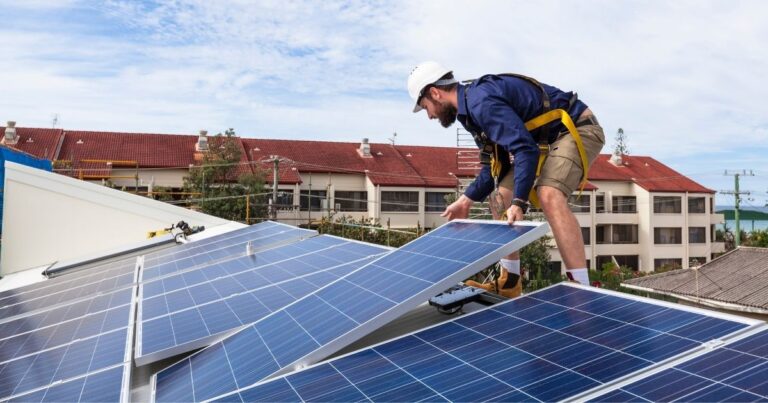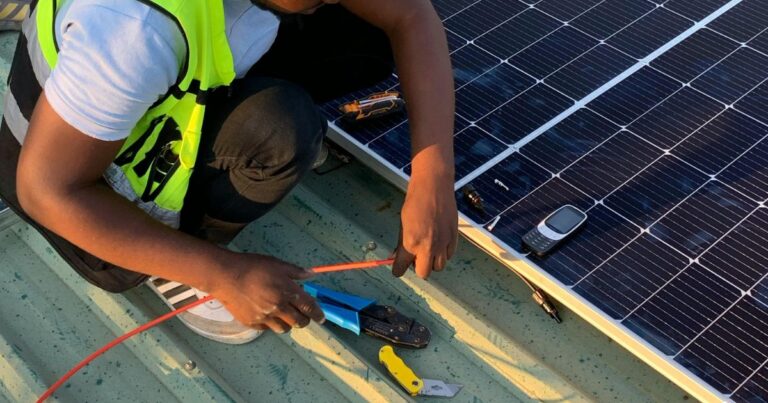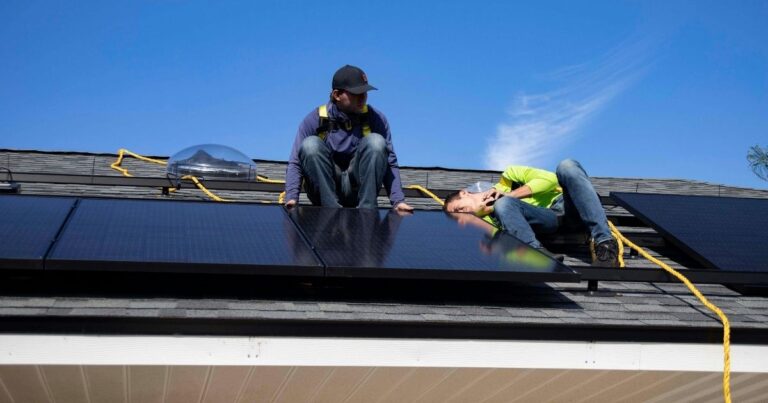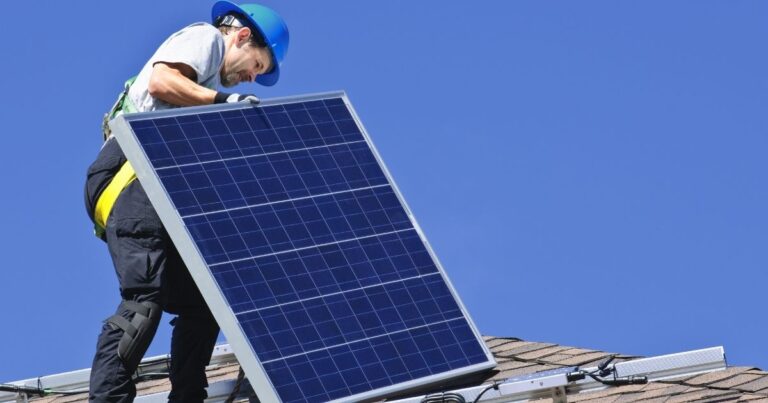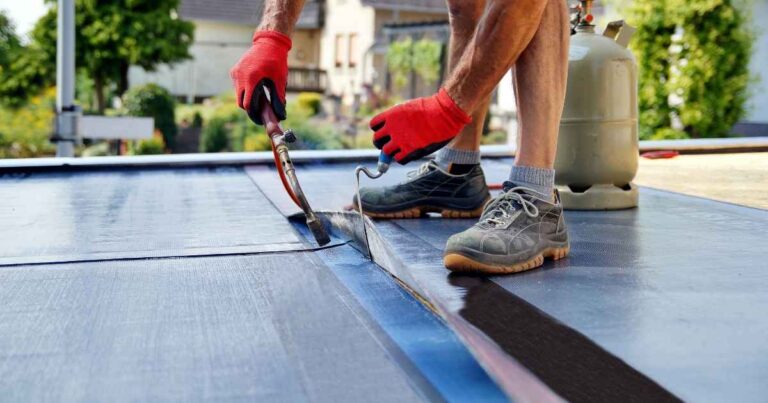Is It Safe to Store Solar Panels During Roof Work?
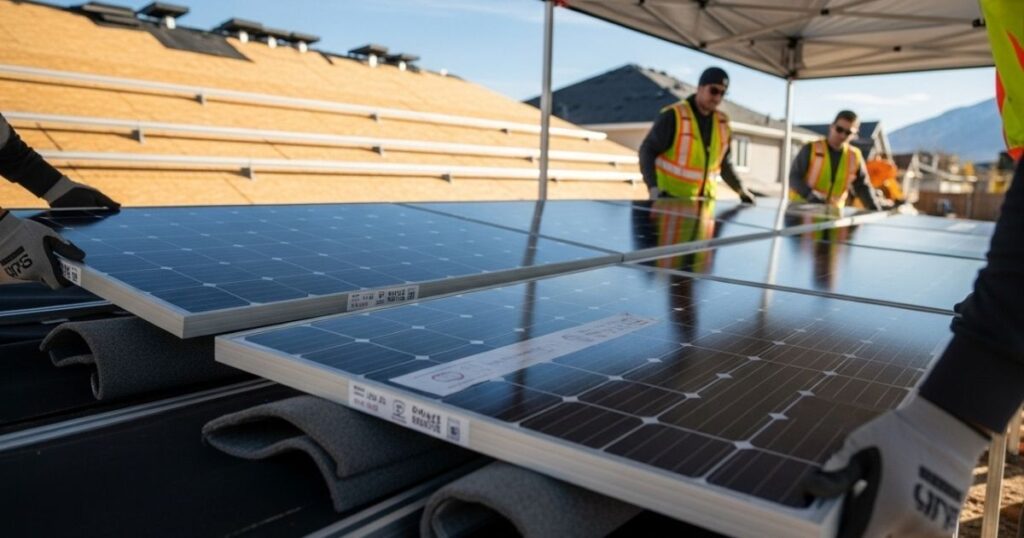
If you have solar panels on your roof and are facing repairs or a full replacement, one question likely stands out: Is it safe to store solar panels during roof work? Whether you’re a homeowner, a roofing contractor, or an insurance adjuster managing a storm damage claim, the stakes are high—improper handling can lead to damaged equipment, voided warranties, or costly delays.
In this guide, you’ll learn why safe storage for solar panels during roof replacement is more than just a convenience—it’s a critical step in protecting your solar investment and keeping your project on track. We’ll also walk through how professional detach and reset services eliminate the risk and confusion often associated with solar system handling.
Here’s what we’ll cover:
- Why Solar Panels Must Be Removed for Roof Work
- Is It Safe to Store Solar Panels?
- The Role of Professional Detach & Reset Services
- How This Affects Homeowners, Roofers, and Insurers
- Local Expertise: Why Northern Utah Residents Trust SwiftSolar D&R
- Conclusion: Safe Storage Isn’t Optional—It’s Essential
Let’s start by looking at why solar panels must be removed before roof work begins.
Why Solar Panels Must Be Removed for Roof Work
Replacing or repairing a roof is no small job—and when solar panels are involved, things get more complicated. It’s natural to wonder if they can just stay put during the process. But here’s the reality: solar panels must be removed before any meaningful roof work begins. Leaving them in place isn’t just inconvenient for your roofer—it can put your solar system and your roof at serious risk.
How Solar Panels Interfere with Roof Replacement
Modern solar panels are mounted directly to your roof, typically drilled into the structure and sealed for weather protection. While that installation is secure and efficient for energy production, it creates a major barrier when it’s time to strip and replace shingles or address structural damage.
If panels remain on the roof during replacement, roofers can’t access the areas beneath the mounts—or safely work around them. This means either cutting corners on your roofing job (not ideal) or forcing roofers to work in tight spaces around expensive, fragile equipment. Neither option protects your property or your long-term investment.
The reality is, a full roof replacement requires full access. Trying to reroof around installed panels would be like trying to repaint a wall without moving the furniture—it slows everything down and leads to incomplete or compromised results.
What Can Go Wrong if Panels Stay Installed
Leaving solar panels in place during roof work can create costly and avoidable problems. For starters, roofers might accidentally damage the panels, wiring, or mounts—none of which are cheap to repair. Even more critically, an improperly executed workaround could void the manufacturer’s warranty on both your solar and roofing systems.
There’s also a safety component. Solar arrays are high-voltage systems. If roofers aren’t trained to handle them—and most aren’t—it creates liability for both the homeowner and the contractor. One wrong move can lead to electrical hazards, damaged components, or injury.
For insurance claims or hail damage repairs, leaving panels in place often results in incomplete documentation or repairs that fall short of claim requirements. That can delay your payout or open the door to future disputes.
Key takeaway: Safe, efficient, and warranty-compliant roof work simply isn’t possible without removing the solar panels first. Professional detach and reset services ensure that both the roofing and solar systems are handled correctly—without cutting corners or taking unnecessary risks.
Is It Safe to Store Solar Panels?
When roofing work is underway, removing your solar panels is only half the equation—what happens to those panels while your roof is being repaired or replaced is just as important. Storing solar panels may sound simple, but doing it wrong can lead to expensive damage, delays, or even voided warranties. The good news? When handled by trained professionals, solar panel storage is absolutely safe.
What “Safe Storage” Really Means
Safe storage isn’t just about keeping panels off to the side. It means securing your solar equipment in a way that protects it from weather, accidental damage, theft, and electrical risk. In Northern Utah, where weather conditions can change quickly—especially in areas like Ogden, Layton, or Logan—panels need to be shielded from hail, moisture, and temperature extremes during roofing work.
That’s why proper storage usually involves placing panels in a clean, dry, padded environment—either in an on-site protective staging area or in a secure off-site facility. Panels are stacked carefully to prevent warping or scratching, and all hardware is labeled and tracked for smooth reinstallation.
Learn more about secure solar panel storage options that help shield your equipment during roof repairs.
Common Risks of Improper Handling or DIY Removal
Trying to remove and store solar panels yourself (or relying on an unqualified crew) can quickly turn into a costly mistake. Solar arrays are high-voltage systems with delicate wiring, fragile glass surfaces, and specific mounting components. Mishandling just one panel can crack the surface, sever a wire, or throw off alignment during reinstall—which can reduce system efficiency or require full replacement.
DIY storage setups—like tossing panels in the garage or stacking them in the backyard—leave them exposed to moisture, impact damage, and theft. Worse, improper disconnection can create serious electrical hazards, especially if panels are left partially energized.
Professional solar uninstall providers follow safe handling protocols to mitigate these risks. They’re trained to deal with the voltage, hardware, and manufacturer-specific requirements that come with storing and reinstalling solar systems.
How Professionals Ensure Safety During Storage
Certified solar panel removal contractors, like SwiftSolar D&R, use approved methods for solar system removal that protect both the panels and the people handling them. This means:
- Fully de-energizing the system before removal
- Carefully labeling and organizing wires and components
- Transporting panels using cushioned racks and padded containers
- Storing them in a climate-safe environment
- Performing thorough checks before and after reinstallation to confirm system integrity and performance
Key takeaway: Yes, it’s safe to store solar panels—but only when done by professionals who know exactly how to protect your equipment. Avoid the risks of DIY handling and choose a certified team that treats your solar system with the care it deserves.
The Role of Professional Detach & Reset Services
When roofing and solar systems overlap, coordination becomes critical. Here are some essential facts about solar detach and reset that highlight why this service is so important. That’s where professional detach and reset services come in—offering a safe, efficient way to remove, store, and reinstall solar panels without jeopardizing your equipment, timeline, or warranty.
Whether you’re a homeowner trying to protect your investment or a contractor managing a tight schedule, having the right solar partner makes all the difference.
What Is a Detach & Reset Service?
A detach and reset service is a specialized process designed to safely remove your solar panels before roofing begins, securely store them during the project, and then reinstall them once the roof is complete—get a full guide to solar panel removal and reinstallation to understand the process. It’s not just about taking panels down—it’s about doing it in a way that ensures they’ll work exactly as they did before, without voiding warranties or causing project delays.
At SwiftSolar D&R, we handle the entire lifecycle of the service, including:
- Disconnecting and de-energizing the system
- Labeling all wiring and hardware
- Protecting panels with padded storage
- Reinstalling panels to their original configuration
- Verifying system performance after reinstallation
This service is especially important during roof replacements, storm restoration, or insurance claim repairs, where timing and accuracy are critical.
How SwiftSolar D&R Protects Your Warranty and Equipment
Solar systems are a big investment—and most come with manufacturer warranties that require specific removal and reinstallation practices. Improper handling, damage during storage, or unlicensed electrical work can all lead to voided manufacturer warranties, leaving homeowners responsible for future repairs.
SwiftSolar D&R follows manufacturer-approved methods and safety protocols that align with warranty requirements. We’re trained to manage both the mechanical and electrical aspects of your system with care and precision. Plus, we carry the proper insurance and documentation to protect you from liability if something goes wrong—giving you peace of mind every step of the way.
In short, we do the job right the first time, so you’re not left with surprise costs or system issues down the line.
Coordinated Scheduling to Prevent Delays
If you’ve ever tried to schedule roofing and solar work separately, you know how frustrating it can be. One team finishes their part, but the other is nowhere to be found—and your project stalls.
SwiftSolar D&R eliminates those headaches by working directly with your roofer or insurance restoration team to ensure everything is aligned. We coordinate timing, share documentation, and make sure your panels are removed and reinstalled exactly when needed. No gaps. No guesswork.
This kind of workflow coordination isn’t just convenient—it’s essential for avoiding timeline delays due to solar systems. For contractors, it keeps jobs moving forward without liability. For homeowners, it means your roof gets done faster, and your solar system is back online with minimal downtime.
Key takeaway: A professional detach and reset service isn’t just a “nice-to-have”—it’s the safest, most efficient way to protect your solar system during roof work. With SwiftSolar D&R, you get skilled handling, warranty-safe processes, and seamless coordination with your project team.
How This Affects Homeowners, Roofers, and Insurers
Handling solar panels during roof work isn’t just a technical challenge—it’s a coordination challenge that impacts everyone involved. Whether you’re a homeowner trying to protect your investment, a roofing contractor juggling timelines, or an insurance professional managing a claim, solar panel removal and storage affects your role in different—but equally important—ways.
For Homeowners
If your roofer has told you, “We don’t touch solar panels,” you’re not alone. Most roofing crews aren’t trained—or insured—to remove or reinstall solar systems. That leaves you, the homeowner, stuck in the middle of a job you didn’t plan for.
This is where a professional detach and reset partner like SwiftSolar D&R steps in. We communicate directly with your roofer, explain the process in simple terms, and handle everything from safe removal to final reinstall. You won’t have to chase multiple contractors or worry about your warranty being voided.
The result? Your panels are protected, your roofing job stays on schedule, and you can move forward with confidence—not confusion. Learn more about our solar services for homeowners.
For Roofing Contractors
Solar panels are a well-known bottleneck in roofing workflows. They can delay jobs, create liability headaches, and frustrate homeowners who don’t understand why you can’t just “move the panels.” But the truth is—handling solar is a specialized skill set, and not having the right subcontractor can cost you time and trust.
SwiftSolar D&R solves this by working as an extension of your team. We offer fast, warranty-safe solar panel removal for roof replacement jobs across Northern Utah, including Ogden, Layton, and Logan. We coordinate schedules directly with you, show up when we say we will, and handle the job without adding confusion or scope creep.
Why it matters: You keep your projects moving, avoid liability, and deliver a better customer experience—all without touching a single panel.
For Insurance & Restoration Teams
Storm and hail damage claims get complicated fast when solar panels are involved. Missing documentation, poorly timed removals, or delays in reinstallation can slow the entire claim process and leave homeowners frustrated. Worse, if solar components are damaged or mishandled, it can open the door to disputes—or even liability claims.
SwiftSolar D&R understands the timelines and documentation requirements insurance professionals need. We provide detailed service records, coordinate directly with restoration contractors, and ensure solar panels are handled in compliance with claim standards. Our process keeps your projects on track and helps you close claims faster—with fewer complications.
Bottom line: With the right solar partner, solar panels don’t have to be a problem—they become just another part of a smooth, well-managed claim.
Key takeaway: No matter your role in the project, a trusted solar detach and reset provider makes the process easier, safer, and more predictable. SwiftSolar D&R bridges the gap between homeowners, roofers, and insurers—so everyone can move forward with less stress and better results.
Local Expertise: Why Northern Utah Residents Trust SwiftSolar D&R
When it comes to protecting your solar investment during roof work, who you hire matters. SwiftSolar D&R isn’t a general contractor dabbling in solar—we’re a specialized team dedicated exclusively to solar panel detach and reset services. And we’re proud to serve communities across Northern Utah with a reputation built on precision, reliability, and trust.
Certified, Insured, and Warranty-Safe Methods
SwiftSolar D&R is a licensed solar subcontractor, trained in both the electrical and mechanical aspects of solar panel removal and reinstallation. We don’t cut corners—and we never risk your warranty.
Our process is built around manufacturer-approved methods, meaning we follow the specific protocols required to keep your solar system protected during roof work. We’re also fully insured, which protects both you and your contractors in the rare event something goes wrong. From start to finish, your panels are handled with care, documented properly, and restored to full performance once your roof is complete.
We’re not just experienced—we’re trusted by roofers, adjusters, and homeowners alike because we do one thing, and we do it right.
Trusted in Ogden, Layton, Logan, and Nearby Areas
We’re proud to be a local Northern Utah solar panel service company, serving communities from Ogden to Layton to Logan—and everywhere in between. Homeowners in these areas rely on us because we’re responsive, easy to work with, and deeply familiar with the region’s climate, building codes, and roofing challenges.
We understand what Utah weather can do to a roof—and how that affects solar systems. Whether you’re dealing with hail damage in Cache Valley or a full replacement in Weber County, SwiftSolar D&R is the go-to team for solar panel removal in Northern Utah.
Need safe storage during your roof work? Get a Free Quote and see why SwiftSolar D&R is trusted across Northern Utah for fast, warranty-safe solar detach and reset services.
Key takeaway: Choosing a local, certified team ensures your solar panels are in good hands—before, during, and after your roof work. SwiftSolar D&R delivers peace of mind, right where you live.
Conclusion: Safe Storage Isn’t Optional—It’s Essential
When your roof needs work and solar panels are in the way, the solution isn’t to guess, delay, or cut corners. Safe storage during roof replacement isn’t just a precaution—it’s essential for protecting your solar investment, avoiding costly damage, and keeping your project on schedule.
We’ve covered why panels must be removed, how improper handling can lead to electrical risks or voided warranties, and why a professional detach and reset service is the safest route. With certified methods, coordinated scheduling, and full insurance coverage, SwiftSolar D&R ensures your system is protected from start to finish.
For homeowners, we provide peace of mind. For roofers, we eliminate workflow bottlenecks. For insurance teams, we help prevent delays and documentation gaps. And across Northern Utah—from Ogden to Logan—we’re the trusted name for solar panel removal for roof replacement.
Protect your solar investment—schedule your detach & reset today. Get a Free Quote from SwiftSolar D&R and let us handle the solar, so your roof work stays on track.
Frequently Asked Questions
No—solar panels must be removed before any roof replacement or major repair work. Leaving them installed restricts access to critical roofing areas and puts both the panels and your roof at risk. It can also create roofing liability with solar panels and potentially void your roof or solar warranty. Safe removal ensures your roofers can do the job right without damaging the solar system.
Safe solar panel storage during roof replacement involves more than just placing panels in a garage or stacking them outside. They should be de-energized, padded, and stored in a clean, dry, secure environment—either on-site in a protected staging area or off-site at a professional facility. This protects your panels from damage, weather, and theft while the roof is being worked on.
Not if it’s done correctly. Most solar warranties require that any removal or reinstallation be performed using manufacturer-approved methods. Hiring a professional service like SwiftSolar D&R ensures solar warranty protection during roof work, so your coverage remains intact and your system performs as expected after reinstall.
Costs can vary based on system size, roof complexity, and storage needs. However, SwiftSolar D&R provides transparent, competitive pricing for solar panel removal for roof replacement throughout Northern Utah. Request a free quote to get a tailored estimate for your project.
SwiftSolar D&R frequently partners with insurance adjusters and restoration contractors handling hail or storm damage. We provide documentation for insurance solar work, coordinate timing with roofers, and ensure panels are safely removed, stored, and reinstalled according to claim requirements. This helps prevent delays and ensures claim compliance.

